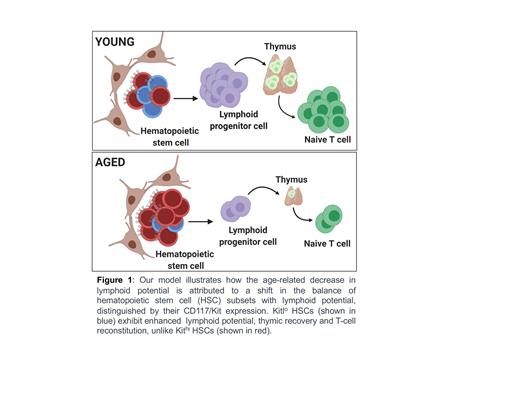Background: Hematopoietic stem cells (HSCs) with multilineage potential are critical for effective de novo T-cell generation and thymic recovery, restoring the adaptive immune system after Hematopoietic Cell Transplantation (HCT). Recent studies have brought new insights into functional heterogeneity within HSCs, revealing an organized and predictable framework governing the adoption of lineage-restricted fates. However, the gene-regulatory networks underlying lymphoid determination and their conservation with aging in HSCs need to be elucidated. This study aims to comprehensively investigate the molecular profile of young and old HSCs and identify HSC subsets with multilineage transcriptional programs.
Results: We conducted single-cell multiomic RNA and ATAC sequencing of young and old HSCs defined by Lineage-CD34-CD48-CD150+Sca-1+Kit+. We identified two CD117 (Kit) HSC subsets, Kit lo and Kit hi, with unique transcriptional profiles. Kit hi HSCs were characterized by quiescence, platelet bias, and low-output gene signatures, while Kit lo HSCs enriched for multi-lineage and high-output gene signatures. We observed a decreased frequency of Kit lo HSCs in aged mice. Although Kit lo HSCs have been previously described to exhibit increased self-renewal (Shin et al. JEM, 2014), their T-cell potential and the molecular underpinnings governing lymphoid differentiation programs are unknown.
We performed in vitro studies, S17 stromal assay, and artificial thymic organoids (ATOs), which revealed an enhanced output of lymphoid progenitors and T-cells from Kit lo HSCs, consistent across all age cohorts. We next compared Kit lo vs. Kit hi HSCs in a competitive allogeneic HCT model. Kit lo HSCs demonstrated improved thymic recovery and post-HCT T-cell reconstitution, independent of age. To orthogonally evaluate post-HCT thymic function, we assessed Recent Thymic Emigrants (RTEs) output, which further substantiated superior recovery in mice receiving Kit lo HSCs. We further observed that Kit lo HSC-derived T-cells exhibited better proliferation in response to an acute Listeria monocytogenes infection. Next, we transplanted middle-aged mice to evaluate the rejuvenation potential of different Kit HSC subsets. We observed that Kit lo HSCs partly mitigated age-related changes in the thymic microenvironment, specifically by enhancing the regeneration of thymic epithelial cells (TECs) in middle-aged mice, thereby reversing the decline in T-cell production.
We found differential expression and activity of key transcription factors (TFs), including Runx3, Zbtb7a, and Ezh1, associated with lymphoid differentiation through integrative transcriptional and chromatin accessibility analyses of Kit lo HSCs. These TFs notably showed distinct patterns in Kit lo HSCs independent of age, indicating their potential role in driving their enhanced T-cell potential.
To establish the existence of a comparable human subset, we interrogated a human BM CITE-Seq dataset (Sommarin et al. Biorxiv 2021) for the mouse Kit lo gene signature. In concordance with our findings in mice, we observed an enrichment of the Kit lo gene program in young HSCs and decreased frequency of Kit lo HSCs in old BM. Next, we used ATOs to validate differential lymphoid potential. We found increased T-cell output originating from Kit lo HSCs, thus underscoring their enhanced lymphoid capacity and potential clinical relevance.
Conclusion: Collectively, we demonstrate a distinct HSC subset, Kit lo HSC, with an age-conserved lymphoid gene program that enhances T-cell production and facilitates thymic regeneration. Importantly, we demonstrate the presence of an analogous HSC subset in humans, revealing the relevance of these insights to human health and disease. Thus, Kit lo HSCs have therapeutic potential to counteract age-associated immune senescence and treatment-related immune suppression.
Disclosures
Leslie:Episteme Prognostics,: Other: SAB member and co-inventor of IP. van den Brink:Da Volterra: Consultancy, Honoraria, Membership on an entity's Board of Directors or advisory committees; Thymofox: Consultancy, Honoraria, Membership on an entity's Board of Directors or advisory committees; GlaxoSmithKline: Consultancy, Honoraria, Membership on an entity's Board of Directors or advisory committees; Vor Biopharma: Consultancy, Honoraria, Membership on an entity's Board of Directors or advisory committees; Wolters Kluwer: Patents & Royalties; Juno Therapeutics: Other: IP licensing; DKMS (a non-profit organization): Membership on an entity's Board of Directors or advisory committees; Pluto Immunotherapeutics: Consultancy, Current holder of stock options in a privately-held company, Honoraria, Membership on an entity's Board of Directors or advisory committees; Lygenesis: Consultancy, Honoraria, Membership on an entity's Board of Directors or advisory committees; Ceramedix: Consultancy, Honoraria, Membership on an entity's Board of Directors or advisory committees; Notch Therapeutics: Consultancy, Current holder of stock options in a privately-held company, Honoraria, Membership on an entity's Board of Directors or advisory committees; Nektar Therapeutics: Consultancy, Honoraria, Membership on an entity's Board of Directors or advisory committees; Frazier Healthcare Partners: Consultancy, Honoraria, Membership on an entity's Board of Directors or advisory committees; Rheos Medicines: Consultancy, Honoraria, Membership on an entity's Board of Directors or advisory committees; Seres Therapeutics: Consultancy, Current holder of stock options in a privately-held company, Honoraria, Membership on an entity's Board of Directors or advisory committees, Other: IP licensing , Research Funding.


This feature is available to Subscribers Only
Sign In or Create an Account Close Modal